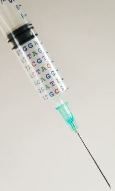- Clinical Technology
- Adult Immunization
- Hepatology
- Pediatric Immunization
- Screening
- Psychiatry
- Allergy
- Women's Health
- Cardiology
- Pediatrics
- Dermatology
- Endocrinology
- Pain Management
- Gastroenterology
- Infectious Disease
- Obesity Medicine
- Rheumatology
- Nephrology
- Neurology
- Pulmonology
What's New in Migraine Therapy?

Migraine affects 13% of the adult population in the United States and is a leading cause of missed work days and loss of productivity.
The introduction of the triptans in 1993 revolutionized the treatment of migraine attacks for millions of migraine sufferers. Here we highlight some recent publications in the headache world. As a practicing clinician who sees headache patients, I will point out the clinical application of these articles to the “real world” of patient care.
Study: Satisfaction with and confidence in needle-free subcutaneous sumatriptan in patients currently treated with triptans. (Cady RK, Aurora SK, Brandes JL, et al. Headache. 2011;51:1202-1211.)
In this open-label study*, subcutaneous sumatriptan, 6 mg was self-administered using a needle-free delivery system (Sumavel DosePro) by 212 migraine patients who were currently using triptans (any form, any dosage) but who reported being less than very satisfied with their current therapy. A statistically significant and clinically relevant increase in satisfaction with therapy and enhanced confidence in treatment was experienced after use of the novel delivery system for up to 4 migraine attacks.
*The editors wish to disclose that this research (NCT01016834 on www.clinicaltrials.gov) was funded by Zogenix, Inc.
Clinical implications for primary care: This is the first available needle-free injection delivery system for sumatriptan-good news for migraine patients who sometimes have difficulty with oral tablets or are uncomfortable with needle injection delivery. The delivery system offers a number of potential advantages for patients: ease of use, efficacy that is comparable to the standard sumatriptan injection, and no concerns about proper needle disposal. Many patients continue to prefer the convenience of an oral tablet for most of their migraines but can benefit from having this needle-free injection option in their “migraine tool box.” Onset of action is 10 minutes: therefore, this formulation is especially suited for those migraine attacks that are rapidly escalating, attacks associated with significant nausea or vomiting, and morning migraines.
Study: Method of injection of onabotulinumtoxinA for chronic migraine: a safe, well-tolerated, and effective treatment paradigm based on the PREEMPT clinical program (Blumenfeld A, Silberstein SD, Dodick DW, et al. Headache. 2010;50:1406-1418.)

This article reviews an evidence-based clinical approach for treating chronic migraine with onabotulinumtoxinA (Botox A). Patient selection, dosing, injection site selection, and injection techniques are discussed in detail. A minimum of 155 units was administered using a fixed-site, fixed-dose paradigm. A maximum of 195 units was administered with the additional 40 units being injected into “follow-the-pain” sites at the clinician’s discretion. The current FDA approval of onabotulinumtoxinA for chronic migraine is for 155 units with 5 units being injected into 31 specific sites across 7 muscles of the head and neck as described in this article.
Clinical implications for primary care: OnabotulinumtoxinA is the only FDA-approved medication for chronic migraine. Insurance companies now need to consider approval of the agent in patients who meet the criteria for chronic migraine and who have failed or are intolerant of standard preventive medications, such as topiramate, propanolol, or an antidepressant such as amitriptyline. Be prepared to discuss this option with chronic migraine patients. This article will be very helpful for clinicians who want to learn how to inject Botox A for chronic migraine.
Study: MAP0004, orally inhaled DHE: a randomized, controlled study in the acute treatment of migraine. (Aurora SK, Silberstein SD, Kori SH, et al. Headache. 2011;51:507-517.)
A phase 3, randomized, double-blind, placebo-controlled, single attack, outpatient study of MAP0004, an orally inhaled dihydroergotamine (DHE), was conducted at 102 sites in 903 adults with a history of episodic migraine. The inhaled DHE was effective and well tolerated; no serious adverse events occurred. Significantly more patients were pain-free at 2 hours following treatment with MAP0004 compared with placebo. Prolonged pain relief relative to placebo was noted at both 24 and 48 hours after treatment.
Clinical implications for primary care: Orally inhaled DHE (Levadex) could prove to be a very good option for acute treatment of moderate to severe migraine attacks. It is a novel formulation of DHE delivered by oral inhalation through a patented inhaler. This product will be an alternative to injectable sumatriptan. Pain-free delivery combined with quick onset of action will be a welcome addition to our current non-oral treatment options. This class of migraine medication has not been associated with medication overuse (“rebound”) and in fact, is often used to help treat medication overuse by headache specialists.
It is hoped that this product will be FDA-approved by early 2012.

Study: Use of nonaspirin nonsteroidal anti-inflammatory drugs during pregnancy and the risk of spontaneous abortion. (Nakhai-Pour HR, Broy P, Sheehy O, Brard A. CMAJ. 2011;183:1713-1720.)
This analysis published in the Canadian Medical Association Journal shows that the use of non-aspirin NSAIDs during pregnancy more than doubles the risk of miscarriage. Specifically, the investigators analyzed information for 4705 women who were between 15 and 45 years of age and determined that the risk of miscarriage was 2.43 times higher in women exposed to non-aspirin NSAIDs than in women who were not. Women who had a planned abortion or a spontaneous abortion after 20 weeks of gestation were excluded. All types of non-aspirin NSAIDS were found to increase the risk. The investigators hypothesized that non-aspirin NSAIDS may suppress prostaglandin synthesis by the uterus during pregnancy, lowering the probability that pregnancies will be maintained.
Clinical implications for primary care: Advise your pregnant patients not to use NSAIDs to treat their migraines. Also, it is probably best that women who are actively trying to get pregnant should avoid these agents. Acetaminophen would be a better choice for treating headache during pregnancy than an NSAID.
Study: Triptan exposure during pregnancy and the risk of major congenital malformations and adverse pregnancy outcomes: results from the Norwegian Mother and Child Cohort Study (Nezvalov-Henriksen K, Spigset O, Nordeng H. Headache. 2010;50:563-575.)
Data for this study was retrieved from the newest dataset released by The Norwegian Mother and Child Cohort Study in December 2008 and records in the Medical Birth Registry of Norway. The study population consisted of 69,929 pregnant women and their newborn children. In this population, 1535 women (2.2%) used triptan therapy during pregnancy. No association was found between triptan use during the first trimester of pregnancy and an overall increased risk of major congenital malformation. No adverse pregnancy outcomes in the triptan group were noted compared with controls. Triptan use late in pregnancy was found to be associated with a slight increase in risk of atonic uterus and hemorrhage during labor.
Clinical implications for primary care: Women who suffer with migraines during pregnancy may be candidates for triptan therapy especially during their first trimester. Although triptans are designated as Category C during pregnancy, there was no increased risk shown in fetal malformations among the large number of women analyzed in this study. Data from triptan registries in the US is similarly positive. You can offer this important reassurance to your female patients who suffer from migraines and are either trying to get pregnant or who are pregnant.
